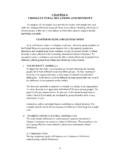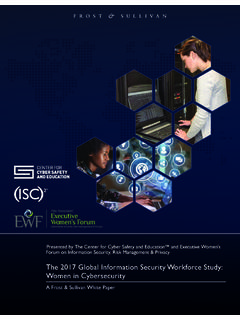Transcription of Workforce Challenges for the Twenty-First Century …
1 1 Workforce Challenges for the Twenty-First CenturyCornelia gamlem , SPHRW orkplace Diversity CommitteeAs we prepare to enter the Twenty-First Century , we see increasing changes within theAmerican Workforce . During the past hundred years, the Workforce moved from the farm to thefactory as the industrial revolution dramatically changed the way people work. This change gaverise to a plethora of laws and regulations designed to address abuses in the labor market such aschild labor, lack of protection against injury, layoff for old age and disability and systemicdiscrimination of groups of individuals that resulted in extreme poverty (Anthony, Perrewe, &Kacmar, 1999). As changes continue, and we move from the industrial to the information age, thechallenges to Human Resource professionals the early 1960s, the issue of employment discrimination emerged to the policy makers were debating models to address discrimination in employment, racial unrestwas giving rise to the Civil Rights Movement.
2 Federal civil rights laws designed to eliminatediscrimination resulted. In 1964, the Civil Rights Act was passed to provide protections inemployment, desegregation of schools, and federal public jobs programs, all aimed at helping thepoor. It was followed by Executive Order 11246 in 1965 that prohibited employmentdiscrimination by federal government contractors. More than thirty years after President Lyndon Johnson signed Executive Order 11246,affirmative action is still widely debated, particularly in the press. The recent debate has failed toaccurately describe affirmative action in the employment context and often confuses it withdiversity initiatives. At the same time, there is a growing trend by lawmakers and policy makersto effect social changes via legal and regulatory vehicles rather than by voluntary corporateefforts.
3 For the Human Resource practitioner, it is important to understand the distinctionbetween federally mandated programs such as affirmative action, and voluntary initiatives toaddress rapidly changing workforces. This paper will explain these distinctions and discusssocial trends that will affect workplace diversity in the next ten action in employment primarily affects companies that receive contracts fromthe federal government. They are required to comply with the regulations governing three laws,namely Executive Order 11246, the Rehabilitation Act of 1973 and the Vietnam Era VeteransReadjustment Assistance Act of 1974. These laws prohibit discrimination and require contractorsto exercise outreach efforts so that protected classes have the opportunity to be hired andadvance in employment without regard to their race, color, religion, sex, national origin, disabilityor veteran status.
4 Rather than providing employment preferences, affirmative action requirescompanies to actively recruit, interview and seriously consider a wider variety of action also requires companies to implement policies and programs to help minoritiesand women advance in employment in those areas of a company s Workforce where thosegroups are not fully represented. Its intention is to remove barriers to employment opportunitiesand to provide equal employment opportunity for all individuals, not to establish hiring quotas forprotected groups. In addition, courts can order companies to establish affirmative actionprograms to remedy the effects of past 1987, the Hudson Institute published a study for the Department of Labor. Workforce2000 reported on Workforce changes projected from 1985 to 2000, and documented a shift inlabor force demographics with growth in ethnic, racial, and gender groupings (Baytos, 1995).
5 These changes would effect not only the workplace , but also external issues such as thechanging face of consumers. Demographics were not the only changes affecting competition and entry into global markets were adding demands and pressures oncorporations. Companies began using a variety of approaches to tap the talent and effectivenessof their work forces, such as high performance work teams. Important to the success of theseteams is the ability of each member to make quality contributions. Companies realized that to beeffective they had to manage the diversity of these teams without impeding productivity (Baytos,1995). Driven by these changes, rather than the legal and regulatory requirements of affirmativeaction, companies began to implement initiatives that addressed the many dimensions of diversitywithin their in the recent debate, the distinction between affirmative action and diversitybecame blurred and the terms were interchanged, leading to the notion that diversity initiativesare merely affirmative action efforts with a different name.
6 However, if we observe the eventsalong a continuum (see Figure 1), society has moved from the golden rule of equal employmentopportunity (treating everyone as you want to be treated), to righting past wrongs that affirmativeaction is designed to address. Incorporated into Affirmative Action is EEO s golden rule and theprinciple of nondiscrimination. Moving along the continuum, initiatives have further evolved toemphasize the importance of valuing differences and the importance of including all employees inthe Workforce , namely workplace diversity. While encompassing the principles of EEO andAffirmative Action, diversity has a broader reach. Comparing and contrasting these approachesto workplace policies we see a number of similarities and differences.
7 Equal employmentopportunity (EEO) and affirmative action are constrained by the boundaries of laws andregulations and have a specific mandate, namely, the prohibition of discrimination againstdefined, protected classes. While EEO offers no guidelines to correcting past discriminatorypractices, affirmative action mandates certain efforts to overcome the effects of past diversity initiatives are not rooted in laws and regulations. They have no definedresponsibilities and no constraints. Therefore, they can be broadly defined to address specificissues within a company. While EEO and affirmative action are rigid, workplace diversity is3flexible. The point, at which the three intersect, however, represents the common goal that theyall share, namely respect (see Figure 2).
8 Figure 1 - Diversity ContinuumFigure 2 - Respect: The CornerstoneDiversity -- Valuing Differences, Respect, InclusionAffirmative Action -- Righting WrongsEqual Employment Opportunity -- The Golden RuleRepresents ConstraintsRepresents No ConstraintsEEOT itle VIIADEAE qual PayActADAAAPEO 11246lRehabilitation ActVEVRAAD iversityValuing Differences Respect4 Corporate diversity initiatives address a wide variety of issues that affect the workplaceand the marketplace. Work force diversity can include tenure with the company, the line ofbusiness an individual supports, functional specialty, geographic region, as well as personalaspects such as age, lifestyle, sexual orientation, education, race, and gender. Globalism, andthe differences and similarities in terms of people, culture, politics, technology, priorities, andlocation, are often core issues within a diversity initiative.
9 Acquisitions and mergers providemixtures of entities that may be different or similar in the nature of the business, corporateculture, vision, mission, and technology. Cross-functional work teams can present a distinct setof diversity issues as companies manage the similarities and differences regarding tasks, goals,communication patterns, and time orientation (Thomas, 1996). In order to design effectivediversity initiatives, it is important to understand the issues and Challenges shaping the workforceand impacting the and policymakers remain concerned about discrimination in employmentpractices. In fact, the trend appears to be moving towards more protections and entitlements,and to increasing the regulation and reporting requirements imposed on companies, therebygiving the government more oversight of, and impact on corporate employment Veterans Employment Opportunities Act of 1998 expanded the class of veteransprotected by VEVRAA.
10 Additionally, the act amended the requirements for VETS-100 to includethe expanded class of veterans and to report the minimum and maximum number of employeesfor the reporting Employment Nondiscrimination Act, which would extend Title VII protection on thebasis of a person's sexual orientation was considered in 1996, but lost by one vote in the ignored it in 1998 and it was re-introduced in 1999. The workplace ReligiousFreedom Act, introduced during 1998, which would amend Title VII to increase the obligation onthe part of employers to accommodate the religious beliefs and practices of their employees, lostmomentum after a number of employer groups raised April 1998, the Clinton administration announced the Equal Pay Initiative, designed toaddress perceived discrimination in corporate pay practices.

